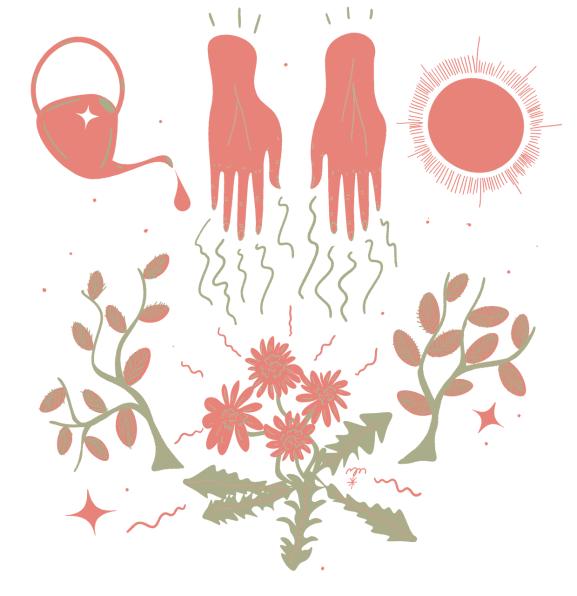
4 minute read
Garden Gems
vii: Garden Gems
Here they come…
Advertisement
Ruth Crighton-Ward
April this year was full of weather extremes; sunshine, high winds and snow— frequently all on the same day. During the nights, there were some heavy ground frosts, with temperatures dropping well below zero. Then warmer, dry, sunny spells. As a result, the poor plants did not know if they were coming or going. Plants such as Hydrangeas (H. macrophylla), which are prone to frost damage, suffered. Those with early flowers, such as Camellias (C. japonica), saw their flowers turn brown and die in the cold. Deciding whether to harden off plants in cold frames, outside, or to keep them indoors was like playing roulette. The winds dried out the top surface of the soil and seedlings struggled to emerge. Hopefully, May will be more settled.
May is often regarded as the best month of the year; the days are longer, and the temperatures tend to be pleasant, often feeling like summer. Watering now starts to be a necessity, so keep an eye on that. The best time to water plants is early in the morning, while the air is still cool. This allows the maximum amount of water to drain into the soil without too much lost to evaporation. Life and work constraints mean it’s not always possible to water at specific times of day, but try to avoid watering when the sun is at its hottest, or at night when the light has gone and the air is noticeably cooler. If you can’t water early in the morning, then do so in late afternoon or early evening while there is still plenty of light, and the heat has not fully gone from the day. If you’re going away on holiday, leaving the garden unattended for a while, then give the most delicate plants a good thick mulch around their base with organic matter and water thoroughly. This will help to keep the roots cool and is also good for water retention.
With the warmer weather come the pollinators, but also the pests. We can’t have one without the other. We want to look after the pollinators, such as bees, whereas we want to discourage the pests. I would strongly warn against using chemicals as pest control. Chemicals do not differentiate between the pollinators and the pests. There are several other means which can be adopted. In the greenhouse, I find one of the most efficient methods is by hand. For insects such as aphids I use a small brush and literally brush them off the plant, squashing them as I do. Check the undersides of the leaves, as they often lurk underneath. Sometimes I use my fingers and rub them off the plant. This does involve one’s fingers getting rather sticky, and may not be for those of a more sensitive disposition. A Garlic (Allium cepa) spray will deter further infestations. If used outdoors, natural sprays should be reapplied at weekly intervals.
Now is a good time to make your own plant feeds. Comfrey (Symphytum officinale) leaves are in abundance in woodlands. Once picked, they should be covered with water and left for about three weeks. The strong odour will be an indication that the brew is ready. This can then be diluted with water, in a watering can, and given to the plants. Comfrey is rich in potassium (K), potash (P) and nitrogen (N). Potassium is good for the development of fruit and flowers, potash for healthy roots, and nitrogen for leaf development. To further enhance the nitrogen content, add Nettle (Urtica dioica) leaves to your preparation. To buy a litre of liquid fertiliser from a garden centre costs around £10, so this is a great money saver.
Then there’s biological pest control— controlling pests using nature itself. For instance, putting ladybirds onto plants with aphids helps remove the aphids, and looks after the ladybirds. Adult ladybirds can eat up to fifty aphids a day, but their larvae can eat many more. Another way to foil the pests is a method known as ‘companion planting’. This involves growing plants next to each other which help each other out. An example is to grow Carrots (Daucus carota subsp. sativus) and Onions (Allium cepa) in between each other. The Carrots help to deter onion fly and the Onion smell helps to deter carrot fly. Garlic is well known as a companion plant and can be planted under Roses (Rosa spp.), Strawberries (Fragaria × ananassa), fruit trees and Tomatoes (Solanum lycopersicum), to name a few. Potatoes (Solanum tuberosum) and French Marigolds (Tagetes patula) work well together, as the Marigolds deter eelworms.
We’ll continue to look at pest control next month, when we focus on the gardener’s worst enemies— slugs and snails. Meanwhile, happy gardening.











